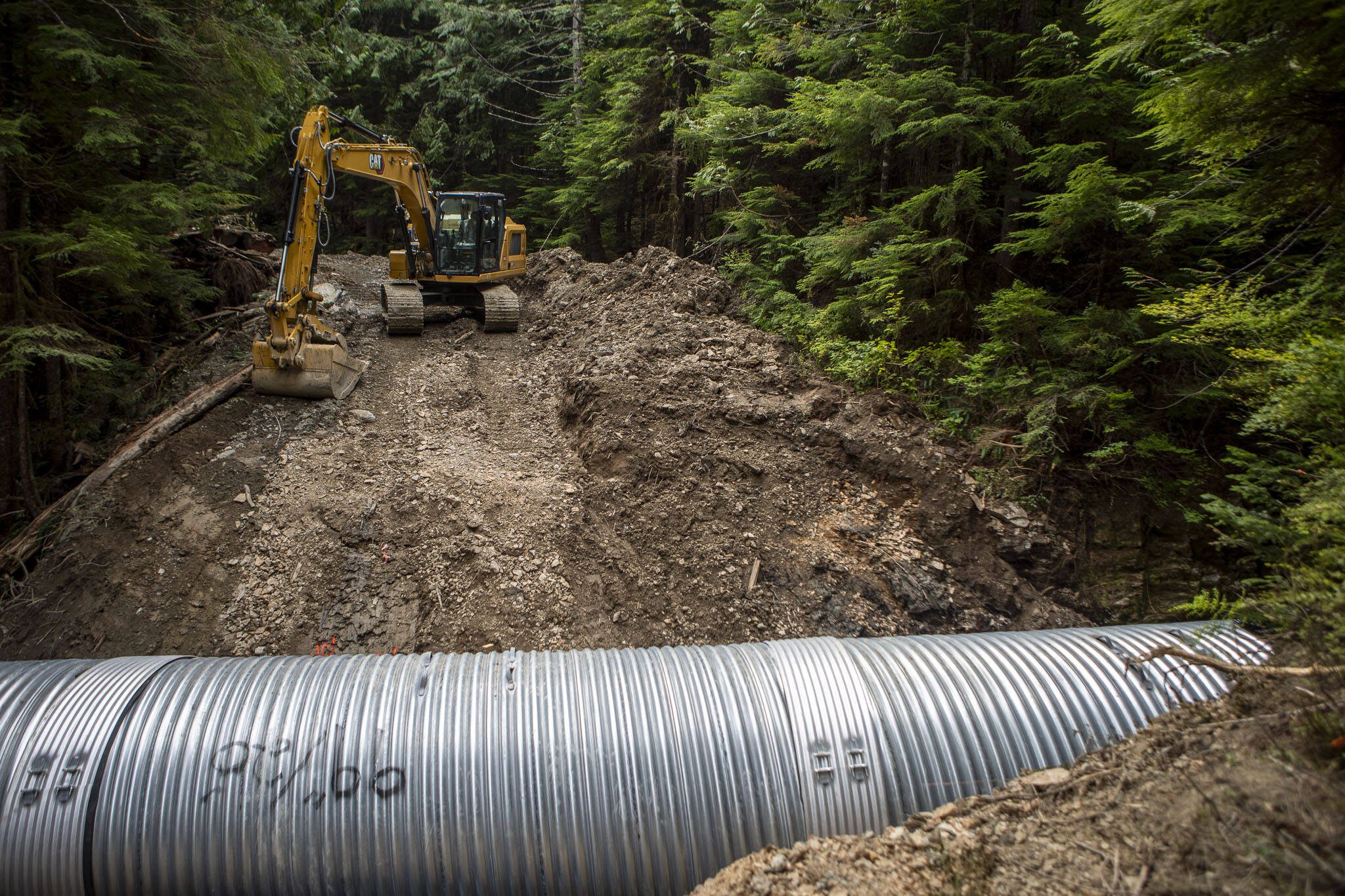VERLOT — Unthinkable a year ago, it’s now possible to get a Prius pretty far up the road to Boardman Lake in the Mt. Baker-Snoqualmie National Forest.
On a recent Monday, that was exactly what Justin Long did. He’s a lead engineer for the federal lands division of the state Department of Natural Resources. There were no trucks available for him to check on the $500,000 road project the state is doing on federal land.
Through a “Good Neighbor Authority” agreement between DNR and the federal government, the state can do certain projects on federal lands. These include forest management and transportation infrastructure.
This project is a makeover for a little over 2½ miles of Forest Service Road 4020 up to Boardman Lake. Prior to the work, the road was filled with massive potholes and rocks.
A high-volume recreation route to a series of lakes alongside Mt. Pilchuck — Ashland, Boardman, Bear, Pinnacle — the road project appealed to DNR.
“We were wanting to find a road we could reconstruct that was in a priority watershed for the DNR … where we could have the biggest impact on restoration,” Long said.
DNR is replacing a dozen culverts, removing brush around tight corners and grading the road. Reshaping the road, along with new ditches, is meant to help slow down potholes from forming.
Forest Service roads 4020 and 4021 have been closed since May. The route is expected to open in the fall.
The Forest Service stressed cooperation in getting this type of project done.
“We don’t have the staffing or the funding, or any of the resources and sometimes even the knowledge to accomplish all the work we need to get done in the forest,” said Jeff Clark, a spokesperson with Mt. Baker-Snoqualmie National Forest. “Being able to work with our partners, like the DNR, is a force multiplier.”
The Good Neighbor Authority, added as part of the federal Farm Bill in 2014, has its roots in an agreement signed by both the state and federal government. DNR now has agreements with every national forest in the state.
It allows the DNR to “hire and collaborate with local companies and interests to perform a variety of watershed, rangeland and forest restoration work on USDA Forest Service and Bureau of Land Management land,” according to its website.
In 2017, DNR also created the 20-year Forest Health Strategic Plan tasking the agency with treating 1.25 million acres of forest at risk for fire across the Cascades. Over 42% of that acreage is on federal land. As of Oct. 31, about 500,000 acres across central and eastern Washington have been restored to “healthy conditions,” according to the state.
Over 4,000 acres in Mt. Baker-Snoqualmie National Forest are slated to be trimmed through the South Fork Stillaguamish Vegetation Management Project. That project was the subject of a lawsuit the Forest Service won earlier this year.
Upgrading trailheads at Boardman Lake is part of the vegetation project. In 2017, the cost to repair 7.99 miles of road to the Pinnacle Lake and Boardman Lake trailheads was $413,222, which was included in the vegetation project’s plans.
The state is repairing 2.58 miles of that road system — Forest Service Road 4020 up to the intersection with 4021.
The federal government classified the project as deferred maintenance, meaning it was priority work, but funding had not been secured. Deferred maintenance projects are sometimes places where DNR can come in, said Will Rubin, a spokesperson for the state agency.
“Being able to bring the state’s resources and then being able to leverage each other, we can kind of help get it over the finish line,” Rubin said.
One of the final pieces of the project was on display last week. A giant water culvert — 10-feet wide and 60-feet long — was placed miles up the road. The pieces of metal were carried up the road by attaching them to an excavator.
The new culvert replaces what’s called a “log culvert,” a cheap option when the road was built over 60 years ago. Essentially, several old growth cedar logs were dropped alongside a creek that flows over the road path.
The cedar logs, about 8-feet wide, then had dirt and lumber piled over them. The road ran over the top. Water ran underneath. Over the years, though, the soil and rock over the old culvert wore down. It needed to be replaced.
The cedar logs themselves looked barely aged when they were dug up this summer. Now the hope is water will flow easier through the new culverts and not wash out the road. It also prevents sediment from entering the watershed, an issue for aquatic life.
“It’s also a barrier to recreation, fire suppression, and even future restoration projects,” Long said. “We engineered the culverts based on current rainfall data and all the culverts are significantly larger now.”
Over 5,000 tons of graveled rock were laid on the road this summer. Cars displace significant amounts of rock when driving on gravel roads, Long said.
Some retaining walls were built along the road as well.
“The public is always looking for a good place to go and to get away, but this also allows the road to be maintained easier,” Clark said. “This road should stay in good condition after this work is done for a long time.”
Jordan Hansen: 425-339-3046; jordan.hansen@heraldnet.com; Twitter: @jordyhansen.
Talk to us
> Give us your news tips.
> Send us a letter to the editor.
> More Herald contact information.



























